Pitted apricot jam - recipes for the winter
This year, more than ever, is rich in the harvest of apricots and perches. By the way, many still do not know what is the difference between these two fruits, since in appearance they are very similar.
The perches are slightly smaller than their apricot counterpart, have a less sweet taste and a more fibrous flesh structure. The apricot is more juicy and the fruit is easier to separate from the stone.
In this article, we will look at making apricot jam for the winter, however, the same recipes can be used for jellied jams as well.
Juicy and fragrant apricot reminds of our Soviet childhood, when a crowd of children, walking in the courtyards, plucked tender, velvet fruits. They used not only the pulp of apricots, but also their seeds - they were dried in the sun, then they split with a hammer and ate the kernels. By the way, we will also consider apricot jam with kernels in this article. So let's get started.
Features of the preparation of dessert
There are quite a few ways to make jam, jam or jam from apricots, and every housewife is looking for the simplest, but delicious recipe. Most often, apricot jam is made without any additives (other than sugar), but additives such as cinnamon, vanilla, citric acid, nuts, and other fruits can be used. You should not neglect the advice of experienced chefs, because it is their experience that allows you to create culinary masterpieces and make preparations so that they delight with their taste all year round and do not spoil.
- For jam, choose slightly unripe fruits, otherwise during the cooking process they will simply boil up and lose their shape. However, this point can be omitted if you are making jam or marmalade. For thickening, use improvised means: gelatin, starch, agar-agar or pectin.
- To make jam or jam, apricot fruits can be twisted through a meat grinder or rubbed through a sieve and sent to the stove in this form.
- For a sweet dessert to become thick, it is not at all necessary to cook it for 2-3 hours. Do not think that the density depends on how much seedless jam you cook. Enough 10 minutes of cooking and 3 runs, between which to wait from 5 to 10 hours. Minimal heat treatment preserves most of the vitamins.
- It is better to cook apricots in a saucepan or large bowl with a thick bottom, but a large evaporation surface. But aluminum dishes are not at all suitable for this purpose - the metal is oxidized and harmful substances are released that distort the taste of the dessert.
- During cooking, it is imperative to remove the foam from the surface, otherwise there is a high probability that the jam will ferment and sour right in the jars.
- To avoid sugaring of the product, a little citric acid (1 g) or the juice of half a lemon per 1 kg of apricots is added to it just before the end of cooking.
- Be sure to sterilize jars and lids.
For dishes, choose not too large jars so that the amount of jam is enough for one or two. Large jars are best used for vegetables.
Often novice housewives ask the question: which apricots make the most delicious jam? To prepare such a dessert, choose bright orange fruits with a red barrel. But leave the pale yellow Armenian apricots for eating fresh.
Jam from poles (apricots) without pits "Pyatiminutka"
Not only is the fastest way to prepare apricot jam for the winter, but also the most useful, since the heat treatment of the fruits is minimal, which allows you to preserve a maximum of vitamins and other useful substances. This particular recipe is ideal for housewives who are looking for how to quickly cook pitted apricot jam (or perch), value their time and at the same time get an excellent result!
Why did we call this jam zherdёlovy or apricot? Because it can be prepared from some fruits as well as from others. The proportions of sugar and fruit are preserved.
Products:
- 2 kg of lightly unripe apricots (or pole)
- 2 kg sugar
For most fruits, this proportion will be the most correct - 1: 1, that is, 1 kg of granulated sugar is taken for 1 kg of fruit. But if you are not a sweet tooth, then the proportion can be slightly changed by reducing the amount of sugar to 700 g per 1 kg of fruit. You can also change the amount of sugar when using sweet fruits and berries, for example, strawberries, peaches, pears.
To make our jam not boiled, and the fruits retain an attractive appearance, then it is worth choosing not too ripe apricots, without dents. You should not process more than 3 kg of fruit at a time, as when cooking you will have to use a large saucepan, in which the lower part of the fruit will turn out to be too soft, and the upper part will not have time to warm up.
Stages of making jam from poles (apricots):
1. Sort out all the fruits, put the spoiled ones aside. Wash and dry the fruits. Divide each fruit into halves and remove the pits.
2. Place the halves in a saucepan or large bowl and cover with sugar. Shake the container slightly to distribute the sugar evenly. Put in the refrigerator for a few hours (you can overnight) so that the fruit is allowed to juice.
Put the container in a cool place, otherwise the future jam may ferment in the heat with sugar.
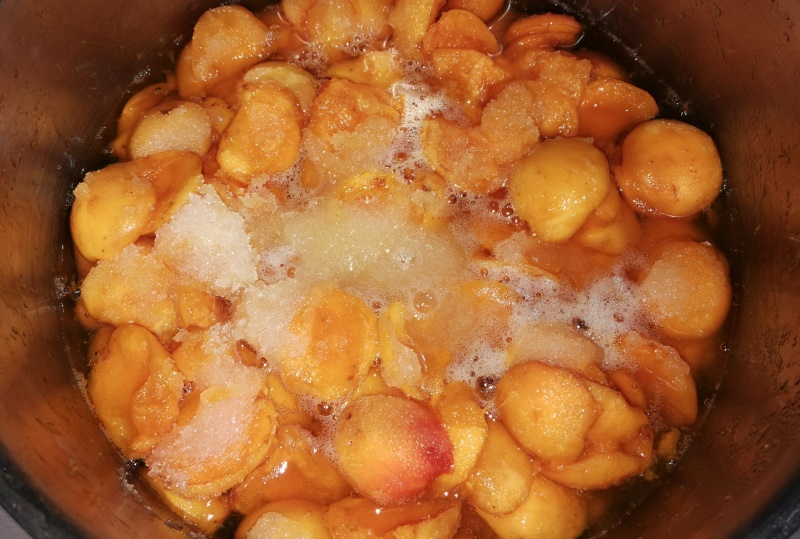
In addition, no liquid should be added - we will cook the poles (apricots) in our own juice, otherwise the jam will turn out to be too liquid.
Now is the time to prepare the jars with lids. Use small seaming jars or screw lids no larger than 500 ml. Experience shows that such an amount of jam is easily eaten and does not have time to turn sour. Sterilize jars with lids in a convenient way and place them on a clean towel so that the glass will have excess water.
4. When the fruit has enough juice so that the halves do not stick to the bottom of the pan (usually night is enough), put the pan on the fire.
5. With constant stirring, bring our pitted apricot jam to a boil and reduce heat. It is better to stir with a wooden spatula. If foam forms on the surface of the jam, then it must also be removed.
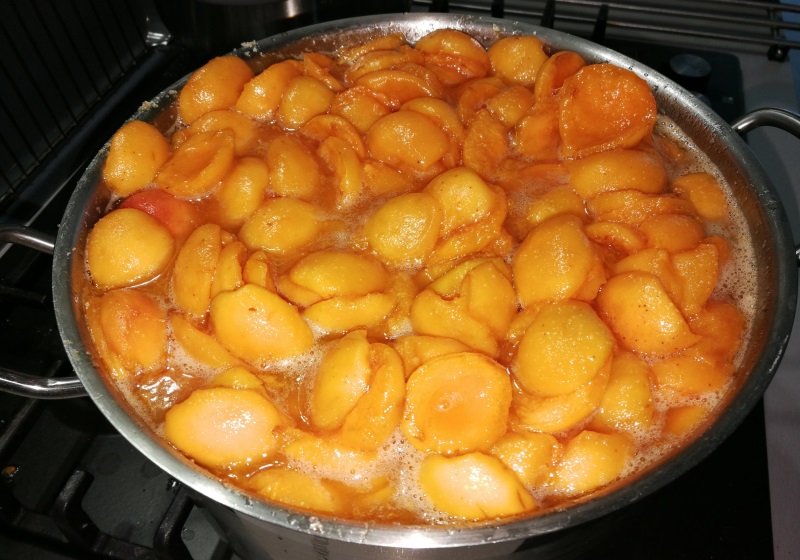
6. Pour hot jam into jars to the very top and roll up (or close with a lid).
Until it cools completely, turn the jars upside down, put them on a towel and wrap them with a blanket. Store ready-made jam from pitted poles (or apricots) in a cool, dark place, but no longer than a year.
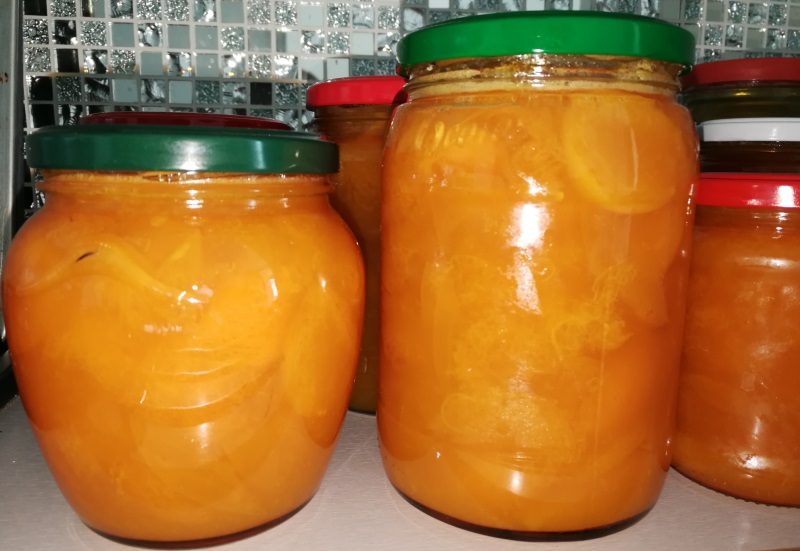
Variant with nucleoli
Such a jam made of whole fruits stuffed with kernels is considered the height of the hostess's skill and is called "royal". The kernels impart a tart taste and pleasant aroma, but can be easily replaced with almonds, hazelnuts or walnuts. And of course, they are eaten first.
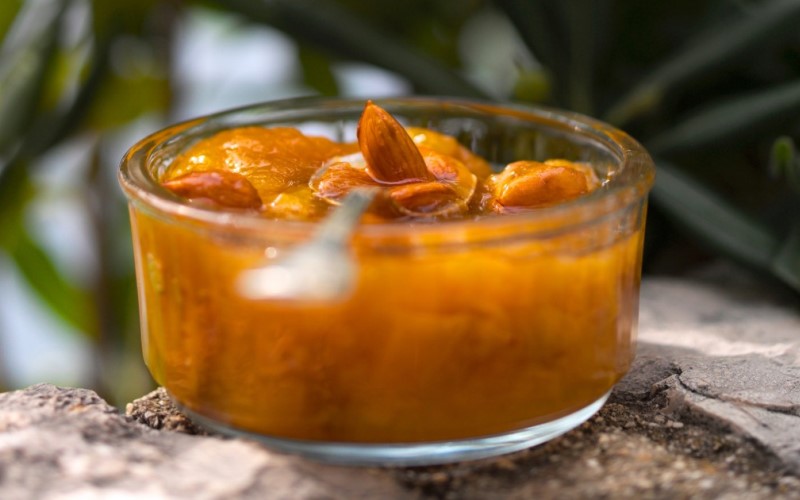
To make jam with kernels, apricots need to be taken not quite ripe, so that they do not boil during cooking. Before cooking, all fruits must be sorted out and defective and rotten ones removed.
Products:
- 2 kg of slightly unripe apricots;
- 1.5 kg of granulated sugar;
- 300 g of apricot kernels or almonds;
- 2-3 tablespoons of water;
- 1 teaspoon of citric acid.
Stages of making apricot jam with kernels:
1. Wash and dry the fruits. Remove the bones from the side of the stalk with a special stick or an ordinary simple pencil.
2. Remove the kernels from the apricot kernels. To peel them, immerse them in a hot 15-20% salt solution at the rate of 150-200 grams of table salt per liter of water. Then pour cold water over and peel off the brown shell. Insert the peeled apricot kernels through the hole in the stalk into the apricots.
Sweet almonds can also be used instead of nucleoli. Almonds are processed in the same way as the kernel.
3. Now it's time to make sugar syrup, in which we will cook the fruits. Pour water into a saucepan, pour sugar and citric acid, put on fire and bring to a boil. You need the sugar to completely dissolve!
4. Gently pour the prepared fruits with sugar syrup (always hot) and leave for several hours. During this time, the fruits should become soft, and the kernels will transfer their aroma and taste.
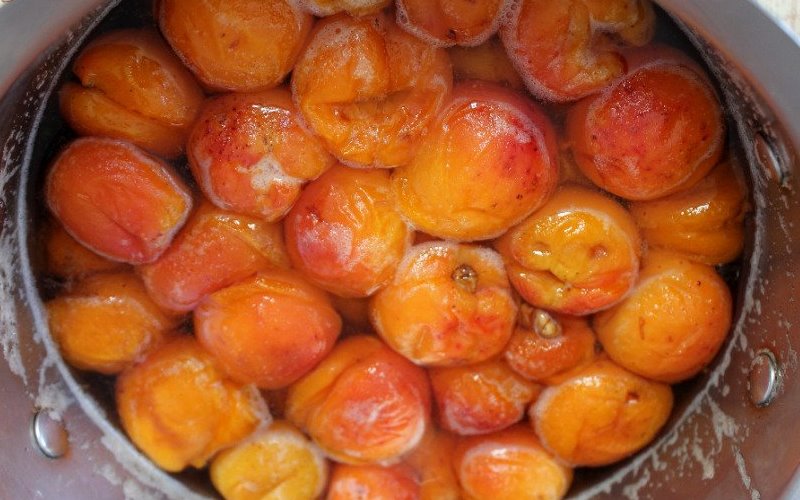
5. We will cook a delicious dessert in two or three passes over low heat, gradually bringing it to readiness. The exposure time between doses is about five hours, the last exposure is 8-12 hours. During cooking, the jam should not be interfered so as not to damage the integrity of the fruit. But the foam that appears on the surface must be removed with a wooden spoon or slotted spoon.
We put the finished sweet in a sterilized glass container at a temperature of 90-95 degrees, roll it up.
If the temperature during packaging was below the above mark, then the jam must be pasteurized at 95 degrees: liter jars - 20 minutes, half-liter - at least 15 minutes.
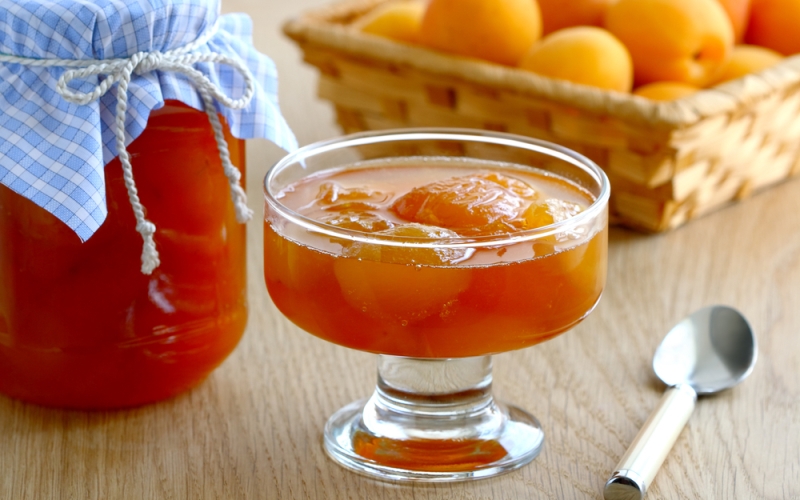
An interesting fact: if jam is prepared where there is an abundance of sun, then it is "boiled" in direct sunlight. By the above method, the prepared apricots are poured with 60% sugar syrup and boiled for 12-15 minutes. After boiling, they are poured into dishes made of earthenware or stainless material and placed in the sun under a gauze canopy. The jam is ready in 8-10 days. Then it is packed in containers, as usual.
In a multicooker
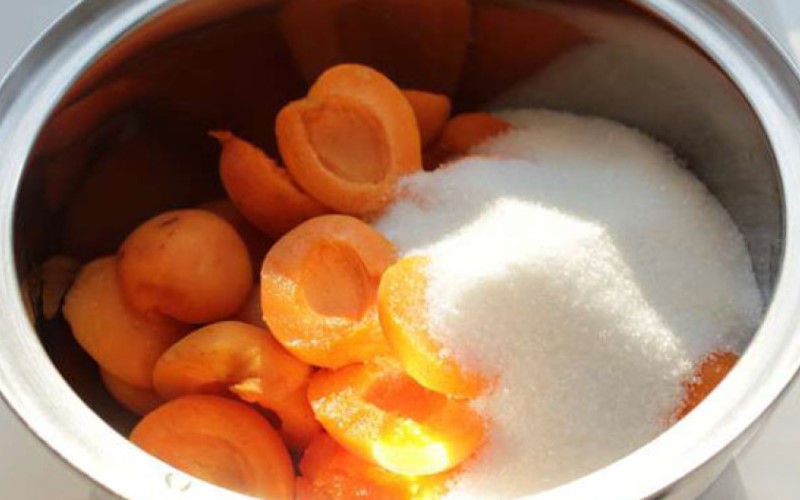
Perhaps the easiest way to make any jam is in a multicooker. As with the previous recipes. for this method we choose firm elastic fruits, without dents.
Products:
- 1 kg of apricots;
- 600 g granulated sugar;
- juice of half a lemon.
Also prepare sterilized jars with lids.
The process of making apricot dessert in a multicooker will be as follows:
1. Wash the fruits, dry them and separate the pulp from the seeds. Put the apricot halves in a multicooker bowl and cover with sugar. Leave in this form for 2-3 hours.
2. When the fruit is juiced, add the juice of half a lemon, close the lid and turn on the "Stew" mode for 1 hour. After 10 minutes, open the lid and remove the foam.
3. Divide the hot mass into clean jars and roll up.
Jam prepared in this way in a multicooker can be stored in a cool place for no more than 1 year.
Original recipe with cognac
The cognac in this recipe plays the role of a seasoning, imparting a special aroma and piquant aftertaste. But the alcohol that is part of the cognac evaporates during heat treatment, so do not think that this dish cannot be eaten by children. This jam also contains cinnamon and lemon. You can also add a vanilla pod if desired.
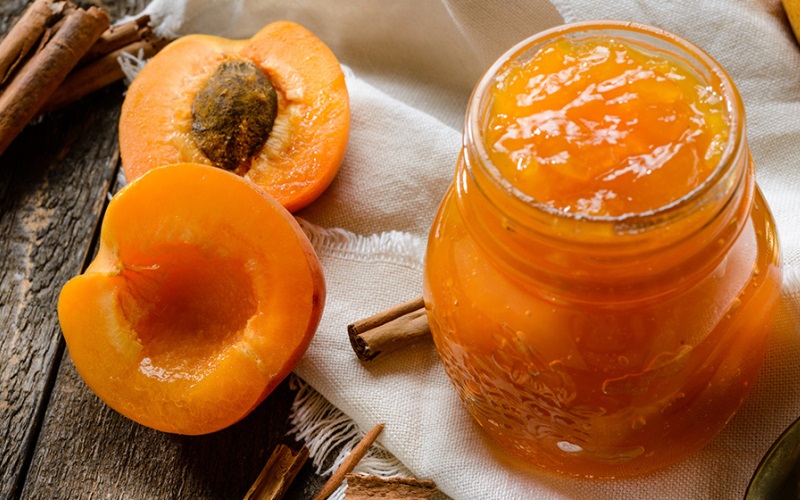
For work we need products:
- 1 kg of ripe apricot fruit;
- 750 g granulated sugar;
- 80 ml of cognac or brandy;
- 200 ml of boiled water;
- a couple of pinches of cinnamon;
- half a lemon.
Stages of making apricot sweetness
First of all, we prepare sweet syrup: pour water into a small container, add sugar and cook until the latter is completely dissolved.
Rinse the apricots, dry and separate the pulp from the stone. We put our fruits in a saucepan, fill with boiling syrup and put on the stove. We cook our jam for 5 minutes. When foam forms on the surface, it will need to be removed with a slotted spoon.
The cooked fruits must be cooled and refrigerated overnight (or for several hours during the day). Already at this stage, you can see that the jam has thickened a little. This is due to the presence of pectin substances in apricot fruits.
After our product has been infused and soaked in syrup, it must be brought to a boil again, pour in brandy, add cinnamon and boil for another 20-30 minutes. Remember to stir occasionally to prevent the fruit from sticking to the bottom.
10 minutes before readiness, add the juice of half a lemon to the mass - it will not allow the jam to be sugared during the winter. Put the finished jam in clean, sterilized dishes and roll up or close the lids. Now we will gently turn the jars upside down and wrap them up with a towel. In this form, hold the jars with dessert until it cools completely.
Whichever of the above methods you choose, you now know exactly how to make pitted apricot and poles jam, and it will be a great addition to your diet in winter.
